Qajar art
From top left to bottom right: Gouache painting by Abu'l-Hasan Sani al-Mulk (1850-1851); Equestrian Statue of Naser al-Din Shah by Mirza Ali Akbar (1888); Young mukhanna and girl, early Qajar Iran; Mirror Hall by Kamal-ol-molk(1876) | |
| Years active | 18th–20th centuries |
|---|---|
Qajar art was the architecture, paintings, and other art forms produced under the Qajar dynasty, which lasted from 1781 to 1925 in Iran (Persia).
The boom in artistic expression that occurred during the Qajar era was a side effect of the period of relative peace that accompanied the rule of Agha Muhammad Khan and his descendants. With his ascension, the bloody turmoil that had been the 18th century in Persia came to a close and made it possible for peacetime arts to again flourish.
Qajar painting
[edit]Most notably, Qajar art is recognizable for its distinctive style of portraiture.
Origins and influences
[edit]The roots of traditional Qajar painting can be found in the style of painting that arose during the preceding Safavid empire. During this time, there was a great deal of European influence on Persian culture, especially in the arts of the royalty and noble classes. European art was undergoing a period of realism and this can be seen in the depiction of objects especially by Qajar artists. The European influence is very well evidenced in the preeminent position and prestige of oil painting. While oil paintings had been par for the course during previous periods of Persian art, it was the influence of the European masters, like Rubens and Rembrandt, the true masters of oil portraiture, that raised it to the highest level. Heavy application of paint and dark, rich, saturated colors are elements of Qajar painting that owe their influences directly to the European style.
Development of painting style
[edit]While the depiction of inanimate objects and still lifes is seen to be very realistic in Qajar painting, the depiction of human beings is decidedly idealised. This is especially evident in the portrayal of Qajar royalty, where the subjects of the paintings are very formulaically placed and situated to achieve a desired effect.
Royal portraiture
[edit]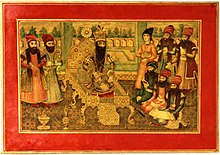
Most famous of the Qajar artworks are the portraits that were made of the various Persian Shahs. Each ruler, and many of their sons and other relatives, commissioned official portraits of themselves either for private use or public display. The most famous of these are the myriad portraits which were painted of Fath Ali Shah Qajar, who, with his narrow waist, long black bifurcated beard and deepest dark eyes, has come to exemplify the Romantic image of the great Oriental Ruler. Many of these paintings were by the artist Mihr 'Ali. While the portraits were executed at various points throughout the life of the Shah, they adhere to a canon in which the distinctive features of the ruler are emphasized. Portraits exist of Fath Ali Shah in a very wide assortment of situations, from the armor-clad warrior king to the flower smelling gentleman, but all are similar in their depiction of the Shah, differing only slightly, usually due to the specific artist of the portrait. It is only appropriate that this particular Shah be so immortalized in this style, as it was under his rule as the second Qajar shah that the style truly flourished. One reason for this were the stronger and stronger diplomatic ties that the Qajar rulers were nurturing with European powers.
As the Shangri La Center for Islamic Arts and Culture notes, "Later Iranian art of the Afsharid (1736–96), Zand (1750–94) and Qajar (1779–1924) periods is distinguished by the depiction of life-size figures, whether in stone relief, tilework or painting on canvas. In the latter category, Qajar rulers like Fath ‘Ali Shah (r. 1797–1834) perpetuated a widespread interest in large-scale portraiture (even sending portraits to political rivals)."[1]
While Fath Ali Shah himself never visited Europe, many portraits of him were sent with envoys in the effort to convey the imperial majesty of the Persian court. With the rise of Naseraddin Shah photography became much more important in the art of the period, and portraiture, while still used for official purposes, fell gradually out of favor. In addition, as Nassirudin Shah was the first Persian ruler to visit Europe, the official sending of portraits was left by the wayside, a relic of times gone by.
Other portraiture
[edit]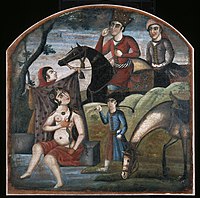
The depiction of nonroyal persons also has a very important place in the explanation and understanding of Qajar art. While naturally not commoners, the subjects of these portraits were often minor princes (of which there were many!), the grandsons, nephews, and great-nephews of the ruling or previously ruling Shahs. These princes, with the wealth and position of their families, had very little else to do but contribute to the arts, so their patronage was certainly less than detrimental to the arts of the time. Often, portraits of this class would be commissioned as depictions of family groups, depicting the male, an idealized, nubile wife, and their perfectly formed child. Other times, they would be in the form of a royal portrait, depicting solely the male commissioner, but with subtle variations making it clear that the sitter is not a Royal. One way that this was accomplished was through a cartouche that was displayed next to the head of each portrait's subject, clarifying who was being depicted, and any relevant titles (such as Soltān, shāhzādeh, &c.). For the ruling head of Persia, this cartouche is fairly regulated, ("al-soltān Official name Shāh Qājār"), while for anyone else, it may include a longer name, a lesser title or a short genealogy.
Depiction of women
[edit]After the spread of Islam in the 600s, the depiction of women in the arts decreased compared to the art movements of the Sasanian time. Portraiture of women started to be considered as a dishonorable practice toward a woman, based on the Islamic traditions of womanhood and modesty.[2] The trend has changed with the arrival of Mongol invasions in Iran. Traditionally, female veiling was not as strict among Turko-Mongol tribes, as prescribed by ancient traditions and the Islamization of society in Iran. Likewise, Mongol women, due to their nomad lifestyle, were conditioned to lead a physically active life, making heavy veiling unpractical. Tribal women were also more politically active, where specifically the lineage of women empowered Timurid Dynasty. Consequently, due to the influences of Mongols and expanding ties with Europe, where Italian renaissance was at its peak, Iranian artists rethought their attitude towards the painting of women. Whereas with time, female nudity and eroticism in painting became a part of Iranian visual culture.[3]
Gender was often blurred in early Qajar Iran paintings, displaying similarities in body and facial features between men and women who were illustrated to be beautiful in many paintings. Young males and females were often linked to the object of desire. The appearance of young beardless men was called "Mukhannas".[4] It was not until the 19th century when females were depicted as more individualized with distinct feminine facial and body features which ultimately led to the disappearance of the mukhanna, the male object of desire.[5] 19th century Qajar art also brought the emergence of the bare-breasted woman. Examples of the bare breast would be seen through a dress for fetishistic pleasure and become a major theme in Qajar paintings. These bare-breasted women were portrayed as angels, European women, or women of pleasure such as acrobats or musicians. Some paintings include a portrayal of Mary and baby Jesus. Eventually, the bare breast led to an indication of womanhood.[6]
The posture and positions women were placed in these paintings help tell a story. Women often held objects such as mirrors, fruit, or wine to represent beauty and pleasure. These representations go in hand with Persian poetry.[7] With Persian literature in mind, occasional paintings featured women with an "outward gaze" which represents "directly addressing the reader"[8] and is seen in many narrative paintings from Shirin and Khusraw, Yusuf and Zulaykha, and Shaykh San'an. In contrast to traditional postures and positions of women in 19th-century Qajar art, was a common female representation of women gracefully upside down on their hands on a knife. This was interpreted as a rejection to a social order which is represented in folk narratives in both pictorial and literary representations to dismiss the stereotype of passive Iranian women.[9]
Female creativity
[edit]Though not well-documented, women have contributed to the 19th-century art heritage of Iran. Due to social, cultural, and religious constraints, art samples created by women were rarely preserved, since society, in general, didn't encourage female self-expression.[3] Qajar women, especially from upper-class families, led creatively and culturally rich lives. Many of them were ambitious writers, poets, artists, calligraphers, religious leaders, and also, activists by the end of the century. “Women’s Worlds in Qajar Iran” is a 21st-century-established digital archive dedicated to recording 19th-century Iranian women's lives and their input into cultural heritage.[10]
Shahs’ harems, in turn, were of considerable importance in regard to women's opportunity to create and promote their art. Harem represented a femicentric space, where women were able to freely exchange and share ideas, not influenced by hierarchal submission to men in 19th-century Iran, experiencing levels of autonomy. It was a place from where female creativity arose.[11]
-
18th-century Qajar art. Girl with mirror, Museum of Georgia
-
Woman playing a daf
-
Woman playing a zarb
-
Woman playing a santur
-
Playing a kamancheh
-
Woman holding a bottle and a glass.
Calligraphy in the Qajar era
[edit]Calligraphy is and has been the definitive Persian art form. There exists a prohibition in Islam against the depiction of sentient beings, similar to the Jewish rule against graven images, and as such, calligraphy and its associated art forms became a very important part of Islamic expression. Upon the introduction of the Arabic script to Persia, the people therein set themselves to making it their own.
The Shāhanshāhnāmeh
[edit]During the reign of Fath Ali Shah Qajar, a work of literature and art was commissioned that was intended to rival the Shāhnāmeh (شاهنامه, lit. "Book of Kings") which was written by Ferdowsi in the year 1000 . This book was called the Shāhanshāhnāmeh (شاهنشاهنامه, lit. "Book of the King of Kings"). The Shahnameh chronicles the quasi-mythical founding of the Persian Empire and the heroes and villains who punctuated its inception. An exemplar of the Sahanshahnameh are now situated in the National Library of Austria.[citation needed]
Qajar textile arts
[edit]The sartorial inclinations of the Qajar period were not so very different from those of earlier period until the latter half of the era. As is evidenced by the early portraiture of Fath Ali Shah Qajar and Mohammad Shah Qajar, the traditional styles of dress in Persia were preserved, but as Western influences became more and more prevalent, the royal portraits began to depict the Shah in a more Western, military style garb (such as the portrait of Nassirudin Shah Qajar above). This is not to say, however, that the traditional textile arts of Persia had fallen into disuse. While the Shah wished to appear advanced and western to European monarchs and diplomats, it was still his duty to exude the pride and ancient glory of the Persian Empire, so court dress retained very strong elements of traditional dress.
Qajar architecture
[edit]
Examples of Qajar era architecture and landscape design Include:
- Constitution House – Tabriz
- Nasir al-Mulk Mosque – Shiraz.
- Golestan Palace Complex – Tehran.
- The Shams-ol-Emareh Palace (1860s) – first iron (steel) building in the city.
- The Niavaran Palace Complex – Tehran.
- The Sahebqraniyeh Palace
- The Kushk of Ahmad Shah pavilion
- Sa'dabad Palace Complex – Tehran.
- The Green Palace
- Eram Garden (Bāgh-e Eram) Persian gardens – Shiraz.
- Shazdeh Garden (1890s) – Kerman.
- Abbas Mirza Mosque – Yerevan (largely destroyed nowadays)
Qajar photography
[edit]Many new technologies were adopted under the rule of Nasir al-Din Shah (ruled 1848 to 1896). Photography became popular in Iran during the late Qajar period and was embraced enthusiastically by Nasir al-Din Shah, who famously photographed many of the women of the Qajar palace. During the period of his rule, the interaction between photography and painting grew, both in terms of style and composition.[12]
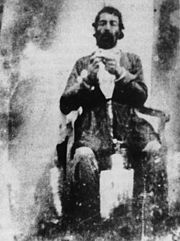
in 1840s daguerreotype were introduced to Persia and paved the way for more photographic instruments to be introduced to Persia. Unlike the Ottoman Empire, where photography was seen as sinful, in Persia it was accepted and largely used. The only surviving daguerreotype photograph is a self-portrait by Prince Malek Qasem Mirza, Naser al-din Shah's uncle.[13]
In 1889, the first essay on photography in Iran entitled Aksiyeh Hashariyeh was written by Mohammad ibn-Ali Meshkat al-Molk.[14]
Women in Iranian photography
[edit]The first photographer to depict women in photos presumably was Naser al-Din Shah. The shah's mother Mahd-i Ulya, is the first Iranian woman to be depicted.[15] Starting in 1858, shah started taking photographs of his harem's residents. Art historian Pamela Karimi also notes that some women from shah's harem were depicted unveiled and “in erotic poses”. In addition to photographing himself, he taught and encouraged his servants to acquire this skill. While cultural and religious restrictions limited women from being depicted in photos, the shah ignored these limitations. Likewise, with the spread of photography as a profession, female rather than male foreign photographers had easier access to photograph Iranian women due to gender restrictions.[15]
Jane Dieulafoy (1851-1916), Isabella Lucy Bishop-Bird (1868-1926), and Gertrude Margaret Lowthian Bell (1869-1926) are three western female travelers in Iran during the Qajar era, who were active in photographing both men, women, and social groups. Under the patronage of Naser al-din Shah, Dieulafoy photographed shah's family members, specifically his wife and daughters. Bird, in her turn, was less interested in depicting women, whereas, in her travelogue Journeys in Persian and Kurdistan on Horseback in 1890, she writes about female daily life and culture in Iran. Gertrude Bell, traveling through Iran in 1911, motivated by archaeological research, was rather concentrated on depicting Iranian landscapes and nature sites, rather than women. However, while photos of men are included in her artistic heritage, there is only one woman among all the photographs done by Bell, and only as a part of a family portrait.[15]
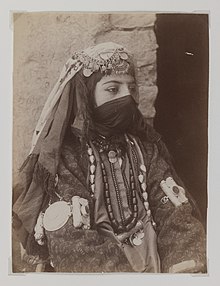
In 1858, male French photographer Frances Carhlian was appointed by the court to teach photography, propagating the collodion method in the state. Carhlian is the first male foreign photographer to depict Iranian women. As for the Iranian photographers except for shah, only members of nobility had an opportunity to develop in photography, since such a hobby required high expenses, inaccessible to all layers of society. Dust Mohammed Khan Mo’ayyer-ol-Mamalek (1856–1912), husband of one of the shah's daughters, together with his brother Mirza, established a photo studio in their house.[15] Possessing fully equipped cameras, they soon became professional photographers, being the first among noblemen, to photograph women. With the spread of female photography, the cultural and religious taboo was gradually declining. Coupled with innovations introduced by western-educated photographers, both Iranian and foreign, court women started to be photographed more often and with time, in a less modest dress. Whereas previously, they were required to be fully veiled in the photos.[15]
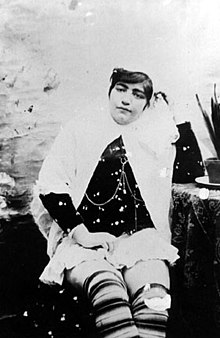
With the increasing mobility of Iranian men at the end of the 19th century (their ability to travel to Europe and get an education), their awareness of the female “presence” in the European societies, coupled with the Constitutional Revolution, helped to significantly change the perception of women in Iranian society. New cultural appropriations changed the depiction of women in the arts as well. For instance, such a genre as family photography emerged, whereas before, only fathers with their children were depicted in photos, excluding mothers. At the end of the 19th and the beginning of the 20th century, women activated to demand more rights. As a rule, education was a privilege of elites. As such educated women with upper-class backgrounds were the ones who started to publish their own newspapers, aiming at combating female illiteracy, and being the mobilizers of women's social movements. With the increase in female opportunities, schools for girls started to be established. And in 1909, Teheran's Naseri Girls’ School adopted photography as one of the subjects taught in the school, rising women's interest in accusing the skill professionally.[15]
Iranian female photographers
[edit]As in any other field, women had limited opportunities in developing professionally, rather being tied to the domestic sphere. Moreover, in the majority of cases, history is depicted by men, who tend to bypass female inputs into society. Consequently, information on female Iranian photographers is significantly limited as well. From the only accessible sources, it is assumed that women from upper-class families and wives of photographers had the greatest opportunity to acquire the skill professionally. As Naomi Rosenblum concluded, after helping the husband in the photo business, a wife herself would frequently continue with it, after her spouse would pass away.[15]
Ozra Khanom, wife of the court photographer Aqa Yusef Akkasbashi, together with her sister Soltan Khanom, worked as a family photographers. Ashraf-os-Saltane, the wife of one of the Naser al-Din Shah's minister and translator, also was active in photography.[15]
Qajar era popular literature
[edit]Popular literature of the Qajar era is of high historical importance since the era itself reflects a transitional time between tradition and modernity. Moreover, the Qajar era represents a period when printing emerged, enabling the development of new literate genres. It also marked a transition from oral propagation to printed literature as a main medium of story-telling. While printing greatly changed the perspective of story distribution, it was not comparable to 21st-century printing capabilities. Lithography is a printing technic that was used in Qajar times; it was invented at the end of the 18th century but has reached Iran only in the second half of the 19th century.[16]
Eminent scholar and researcher of Iranian folklore Mohammad Ja’far Mahjub contributed to the study of the Qajar literature by outlining and classifying the main topics that were present in the literature of that period.[16] These included:
- imagined stories
- stories with historical background
- stories inclusive of religious motives
- stories about the historical importance of religious actors
- adventure stories
- stories with animal actors
- classical Persian poetry
Many samples of Qajar-era popular literature have been lost or poorly preserved. Comparatively major holdings of Iranian literature heritage are mainly held in Iran, but also Russian, English, German and French libraries; and in personal collections.[16]
Female input into Qajar literature
[edit]A period of Qajar rule was characterized by a move from neoclassic literary tradition inherent of conservative Islamic society to reformist aesthetics of pre-constitutional revolution. It served as a basis for significant changes in the perception of literature, and the role of women in producing it.[17] Muhammad Shah(1834–1848) and Naser al-Din Shah were essential figures in “liberating” female creativity and promoting it. While there is a belief that women didn't contribute to the Iranian culture, in reality, women facilitated reformist ideas in their writings no less than men and were responsible for the establishment of girls’ schools in Iran in the late Qajar empire, early Pahlavi rule period.[17]
Poetry
[edit]While female literacy used to be a privilege of elites, many women were enthusiastic admirers and compositors of poetry. Under the patronage of Iranian royalty, female poets were promoted, even though society saw women's writing as a transgressive act. It is also considered that Hajji Gawhar Khanum is the first female poet whose poetry has been published under Qajar rule. Her poetic inputs date back to the reign of Naser al-Dln Sháh.[11]
Gallery
[edit]| Part of a series on the |
| Culture of Iran |
|---|
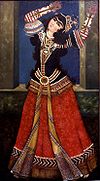 |
|
|
- Qajar art
-
Qajari wall painting at Qavam House—Narenjestan e Qavam.
-
Muqarna at the Nasir al-Mulk Mosque.
-
Qavam—Ghavam House facade and balcony.
-
Qavam House
-
"Kushk of Ahmad Shah" at the Niavaran Palace Complex.
-
Boy Holding a Falcon, Qajar Dynasty
-
Eram garden
-
Tiles painted with polychrome glazes over a white glaze.
-
Beglyar Afshar. Portrait of Jamshid Ed-Dovle
-
Painted tiles with design of birds, hunting and flowers from Qajar dynasty
-
Portrait of Muhammad Shah Qajar and his Vizier Haj Mirza Aghasi, second quarter of the nineteenth century, Ink, opaque watercolor and gold on paper, Iran, collection of the Metropolitan Museum of Art.[18]
-
Pottery scene from 19th century Qajar, Iran, showing two seated princely figures, surrounded by courtiers, musicians and dancing girls.
-
Qajar prince, holding a parasol watches a musician and two dancers. 19th century.
See also
[edit]- Royal Persian Painting in Qajar era
- Malik National Museum of Iran
- Cultural Heritage Organization of Iran
- Shangri La (Doris Duke)
- Esmail Jalayer
References
[edit]- ^ "Doris Duke's Shangri La | Painting". www.shangrilahawaii.org. Retrieved 2016-12-18.
- ^ Scheiwiller, Staci Gem (2017). Liminalities of Gender and Sexuality in Nineteenth-Century Iranian Photography. Desirous Bodies. New York: Routladge. p. 33. ISBN 9781138201293.
- ^ a b Scheiwiller, Staci Gem (2017). Liminalities of Gender and Sexuality in Nineteenth-Century Iranian Photography. New York: Routladge. ISBN 9781138201293.
- ^ Najmabadi, Afsaneh (2005). Women with Mustaches and Men without Beards: Gender and Sexual Anxieties of Iran Modernity. University of California Press. p. 16.
- ^ Najmabadi, Afsaneh (2005). Women with Mustaches and Men without Beards: Gender and Sexual Anxieties of Iran Modernity. University of California Press. p. 26.
- ^ Najmabadi, Afsaneh (2005). Women with Mustaches and Men without Beards: Gender and Sexual Anxieties of Iran Modernity. University of California Press. p. 39.
- ^ Vanzan, Anna (2014). "The Popularization of Art in Late Qajar Iran: The Importance of Class and Gender". Quaderni Asiatici: 146.
- ^ Najmabadi, Afsaneh (2005). Women with Mustaches and Men without Beards: Gender and Sexual Anxieties of Iran Modernity. University of California Press. p. 30.
- ^ Vanzan, Anna (2014). "The Popularization of Art in Late Qajar Iran: The Importance of Class and Gender". Quaderni Asiatici: 150.
- ^ Najmabadi, Afsaneh (July 2016). "Women's Worlds in Qajar Iran Digital Archive and Website". Journal of Middle East Women's Studies. 12 (2): 246–249. doi:10.1215/15525864-3507661. S2CID 148411419.
- ^ a b Brookshaw, Dominic Parviz (January 2013). "Women in Praise of Women: Female Poets and Female Patrons in Qajar Iran". Iranian Studies. 46 (1): 17–48. doi:10.1080/00210862.2012.740902. JSTOR 24482799. S2CID 162261598.
- ^ "Photography in Qajar Iran".
- ^ "Welcome to Encyclopaedia Iranica".
- ^ "Iranian portrait photography developed during Qajar era". 14 September 2004.
- ^ a b c d e f g h Mohammadi Nameghi, Khadijeh; Pérez González, Carmen (January 2013). "From Sitters to Photographers: Women in Photography from the Qajar Era to the 1930s". History of Photography. 37 (1): 48–73. doi:10.1080/03087298.2012.718142. S2CID 216590349.
- ^ a b c Marzolph, Ulrich (2001). "Persian popular literature in the Qajar Period". Asian Folklore Studies. 60 (2): 215–236. doi:10.2307/1179055. JSTOR 1179055.
- ^ a b Brookshaw, Dominic Parviz (October 1, 2014). "Qajar Confection: The Production and Dissemination of Women's Poetry in Early Nineteenth-century Iran". Middle Eastern Literatures. 17 (2): 113–146. doi:10.1080/1475262X.2014.928040. S2CID 162258041.
- ^ "Portrait of Muhammad Shah Qajar and his Vizier Haj Mirza Aghasi".
Further reading
[edit]- Diba, Layla S., with Maryam Ekhtiar. Royal Persian Painting: The Qajar Epoch, 1785–1925. Brooklyn, NY: Brooklyn Museum of Art with I.B. Tauris, 1998.
- Raby, Julian. Qajar Portraits : Figure Paintings from Nineteenth Century Persia. Brooklyn, NY: I.B. Tauris, 1999.
- Loukonine, Vladimir. Lost Treasures of Persia: Persian Art in the Hermitage Museum. Mage Publishers. 1996.
- Ritter, Markus. Moscheen und Madrasabauten in Iran 1785-1848: Architektur zwischen Rückgriff und Neuerung (Mosque and Madrasa Buildings in Iran 1785-1848: Architecture between re-adaptation and innovation). German, English summary. Brill Publishers: Leiden and Boston, 2005.
- Uzun, Tolga. "Qajar Portrait Art In The Second Half Of The 19th Century: The Portraits Of Nasir Al-Din Shah", Ph.D. Thesis - Department of Art History- Hacettepe University, Ankara, Turkey 2005.
























![Portrait of Muhammad Shah Qajar and his Vizier Haj Mirza Aghasi, second quarter of the nineteenth century, Ink, opaque watercolor and gold on paper, Iran, collection of the Metropolitan Museum of Art.[18]](http://upload.wikimedia.org/wikipedia/commons/thumb/5/58/Portrait_of_Muhammad_Shah_Qajar_and_his_Vizier_Haj_Mirza_Aghasi_MET_DP345140.jpg/169px-Portrait_of_Muhammad_Shah_Qajar_and_his_Vizier_Haj_Mirza_Aghasi_MET_DP345140.jpg)

